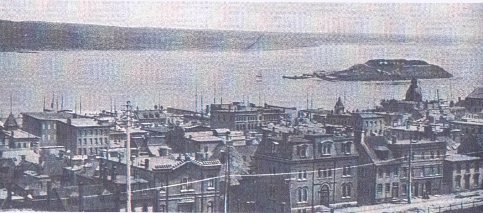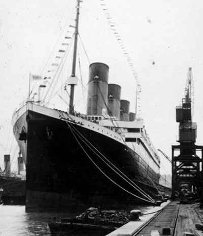

In 1749, Halifax, Nova Scotia, was founded for war. The British chose this sea-side harbour, originally called "Chebucto" by the natives, as a way to keep a close eye on the French fortress of Louisbourg, on L'Isle Royal, what is now know as Cape Breton. Even after the french were finally driven out of Louisbourg, Halifax remained as one of England's most crucial settlements in times of war, and it was times like these that she propsered. Halifax was often the first city in North America to recieve news from London, or fashions from Paris. Throughout the 19th century, Halifax was inhabited by princes, privateers and pirates, and was visited by the world's most influential personalities, such as Charles Dickens. Shipping being her most prominent and passionate means of making money, it was no wonder Halifax would produce it's own celebrities in the industry, such as Samuel Cunard, who founded the Cunard Line, a company still popular and prosperous in today's maritime industry.
The city has always been somewhat divided by class: the North End of the city was always home to the working class, men and women who worked in factories and lived in poorly constructed houses; The South End was entirely first class, and these people lived in spacious luxury, belonged to the local yacht clubs and played polo. At the base of Citadel Hill, along the harbour, was the business district.
map
Industry ruled the 20th century, and Halifax was no exception. Inventors
such as Marconi and Bell, both pioneers in comminucation, inhabited the
province. Dubbed "the guilded age" by Mark Twain, Halifax was no exception.
In 1905,  Halifax was freed of British rule and became a part of the Dominion
of Canada. British Military pulled out of Halifax, and she was left to
stand on her own two feet after over 150 years. While the 20th century brought promise, it also brought it's share of
tragedy. In January of 1912, Halifax was ravaged by fires that ate up many
businesses. And in April of that year, White Star's passenger liner, Titanic,
struck an iceberg off the coast of Newfoundland and foundered.
1500 of it's passengers were killed, including Halifax millionaire,
first class passenger, George Wright. Several vessels based in Halifax
were comissioned by the White Star line to retrieve the bodies. The bodies
were brought back to Halifax and the final resting place for 150 of Titanic's
dead.� While Titanic was an incredible tragedy felt around the world,
an invaluable resource came from the sinking. An system of recording the
unidentified dead was invented, of tagging the toes with a number, and
this number recorded in a log book along with the victim's description
and any personal effects found on the body. This system would be remembered
5 years later when Halifax experienced it's own tragedy.
Halifax was freed of British rule and became a part of the Dominion
of Canada. British Military pulled out of Halifax, and she was left to
stand on her own two feet after over 150 years. While the 20th century brought promise, it also brought it's share of
tragedy. In January of 1912, Halifax was ravaged by fires that ate up many
businesses. And in April of that year, White Star's passenger liner, Titanic,
struck an iceberg off the coast of Newfoundland and foundered.
1500 of it's passengers were killed, including Halifax millionaire,
first class passenger, George Wright. Several vessels based in Halifax
were comissioned by the White Star line to retrieve the bodies. The bodies
were brought back to Halifax and the final resting place for 150 of Titanic's
dead.� While Titanic was an incredible tragedy felt around the world,
an invaluable resource came from the sinking. An system of recording the
unidentified dead was invented, of tagging the toes with a number, and
this number recorded in a log book along with the victim's description
and any personal effects found on the body. This system would be remembered
5 years later when Halifax experienced it's own tragedy.